Sporobolus heterolepis (Prairie Dropseed)
| Also known as: | |
|---|---|
| Genus: | Sporobolus |
| Family: | Poaceae (Grass) |
| Life cycle: | perennial |
| Origin: | native |
| Habitat: | sun; moist to dry sandy or gravelly soil; prairie, rock outcrops |
| Fruiting season: | August - October |
| Plant height: | 1 to 3 feet |
| Wetland Indicator Status: | GP: UPL MW: FACU NCNE: FACU |
| MN county distribution (click map to enlarge): |  |
| National distribution (click map to enlarge): |  |
Pick an image for a larger view. See the glossary for icon descriptions.
Detailed Information
Flower: 

![[photo of panicles]](/udata/r9ndp23q/pd3/sporobolus-heterolepis-79-1-t.jpg) An open spreading panicle at the tip of the stem, elliptic to pyramidal in outline, 2 to 8 inches long, ¾ to 2½ inches wide. Branches are compound, both primary branches and secondary branchlets erect to ascending, with spikelets (flower clusters) loosely arranged on the branch, giving the panicle an airy appearance. Spikelets are lance-elliptic in outline, nearly round in cross-section, 4 to 6 mm (to ¼ inch) long, light green to purplish, with a single floret, and very slender when immature though much expanded at maturity.
An open spreading panicle at the tip of the stem, elliptic to pyramidal in outline, 2 to 8 inches long, ¾ to 2½ inches wide. Branches are compound, both primary branches and secondary branchlets erect to ascending, with spikelets (flower clusters) loosely arranged on the branch, giving the panicle an airy appearance. Spikelets are lance-elliptic in outline, nearly round in cross-section, 4 to 6 mm (to ¼ inch) long, light green to purplish, with a single floret, and very slender when immature though much expanded at maturity.
![[photo of branch with immature spikelets]](/udata/r9ndp23q/pd3/sporobolus-heterolepis-152-t.jpg) At the base of a spikelet is a pair of bracts (glumes), both thin, hairless, awnless, 1-veined with a long taper to a sharply pointed tip and minute teeth towards the tip end, the lower glume lance-linear, 2 to 3.5 mm long and half to ¾ as long as the spikelet, the upper glume 4 to 6 mm long, about as long as the spikelet or nearly so. Florets are surrounded by a pair of bracts (lemma and palea), both thin and egg-shaped with a pointed tip, the lemma 1-veined and 3 to 4.8 mm long, the palea 2-veined and as long as to slightly longer than the lemma, though may appear shorter when fully mature.
At the base of a spikelet is a pair of bracts (glumes), both thin, hairless, awnless, 1-veined with a long taper to a sharply pointed tip and minute teeth towards the tip end, the lower glume lance-linear, 2 to 3.5 mm long and half to ¾ as long as the spikelet, the upper glume 4 to 6 mm long, about as long as the spikelet or nearly so. Florets are surrounded by a pair of bracts (lemma and palea), both thin and egg-shaped with a pointed tip, the lemma 1-veined and 3 to 4.8 mm long, the palea 2-veined and as long as to slightly longer than the lemma, though may appear shorter when fully mature.
Leaves and stems: 


![[photo of sheath hairs and ligule]](/udata/r9ndp23q/pd3/sporobolus-heterolepis-121717-13-t.jpg) Leaves are basal and alternate on the lower stem, 1 to 2 mm wide, 12 to 24 inches long, hairless but slightly rough on the underside and along the edges, flat or folded or rolled in along the edges (involute) giving a wiry appearance. The sheath is hairless except occasionally for a few sparse hairs at the tip. The ligule (membrane where the leaf joins the sheath) is a fringe of short hairs. Nodes are smooth.
Leaves are basal and alternate on the lower stem, 1 to 2 mm wide, 12 to 24 inches long, hairless but slightly rough on the underside and along the edges, flat or folded or rolled in along the edges (involute) giving a wiry appearance. The sheath is hairless except occasionally for a few sparse hairs at the tip. The ligule (membrane where the leaf joins the sheath) is a fringe of short hairs. Nodes are smooth.
![[photo of tufted base]](/udata/r9ndp23q/pd3/sporobolus-heterolepis-68734-5-t.jpg) Stems are slender, hairless, erect to ascending, and multiple from the base. Vegetative shoots are numerous, forming dense mounds of flowering and non-flowering stems, the arching leaves radiating from the center of the clump.
Stems are slender, hairless, erect to ascending, and multiple from the base. Vegetative shoots are numerous, forming dense mounds of flowering and non-flowering stems, the arching leaves radiating from the center of the clump.
Fruit: 
![[photo of mature spikelet and grains]](/udata/r9ndp23q/pd3/sporobolus-heterolepis-121717-11-t.jpg) Spikelets turn straw-colored to brown or gray at maturity, the enlarged grain (seed) pushing the spikelet apart, often splitting the palea down the middle. Mature florets drop off individually leaving the glumes behind on the stalk. Grains are shiny yellowish brown, nearly round in outline, 1.5 to 2 mm long, not much flattened.
Spikelets turn straw-colored to brown or gray at maturity, the enlarged grain (seed) pushing the spikelet apart, often splitting the palea down the middle. Mature florets drop off individually leaving the glumes behind on the stalk. Grains are shiny yellowish brown, nearly round in outline, 1.5 to 2 mm long, not much flattened.
Notes:
Prairie Dropseed is found throughout Minnesota's prairie regions and is widely adapted to soils ranging from dry and sandy and rock outcrops to low, wet mesic habitats. It is long-lived, forming large, readily recognizable low mounds of fine, dense, hair-like leaves, though it doesn't necessarily stand out in mixed vegetation. Its open spreading panicles are so airy, you can walk right by them and hardly notice. However, in late summer to early fall when many native grasses are turning reddish brown, its golden color is highly visible. All these characteristics make it highly ornamental and it's become quite popular in more formal residential landscapes. Prairie Dropseed is also one of the most fragrant grasses, from small glands at the base of branches.
Native Plant Nurseries, Restoration and Landscaping Services ↓
More photos
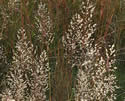 Sporobolus heterolepis plant
Sporobolus heterolepis plant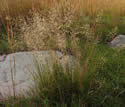 Sporobolus heterolepis plant
Sporobolus heterolepis plant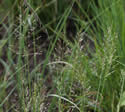 Sporobolus heterolepis plant
Sporobolus heterolepis plant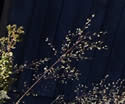 garden-grown Sporobolus heterolepis
garden-grown Sporobolus heterolepis golden clumps as seen in fall
golden clumps as seen in fall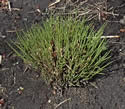 clumps emerging in spring
clumps emerging in spring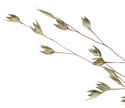 scan of panicle
scan of panicle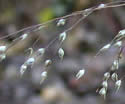 late season panicle with spikelets turned gray
late season panicle with spikelets turned gray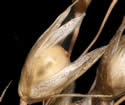 close-up of mature branches
close-up of mature branches
Photos by K. Chayka taken in her garden. Photos courtesy Peter M. Dziuk taken in Big Stone, Dakota, Pope and Ramsey counties.
Comments
Have you seen this plant in Minnesota, or have any other comments about it?
on: 2018-06-05 09:26:55
Can you tell me if Sporobolus heterolepis (Prairie Dropseed)tends to "escape" and spread? I am concerned about it getting into the lawn and other areas of my garden outside of its intended spot in my "native prairie" area. Thank you. Shelley
on: 2018-06-06 11:53:16
Shelley, we have prairie dropseed in a small prairie area in our garden. The number of clumps has expanded in the garden (1 or 2 a year) but we haven't noticed it spreading into the lawn.
on: 2022-10-27 22:16:50
Distributed across Amador Prairie north of the trail center in Wild River State Park...has been part of my Prairie Care collection there for quite some time. Isn't "close" to the tc but keep going past the large burn pile where it's interspersed with Leadplant, Hoary Vervain, Silky Prairie Clover, Canada Wildrye, Switchgrass, and gramagrasses (sideoats, Hairy) et al.
on: 2023-05-16 10:33:41
Our property has a slope leading to a steep ravine behind our house. It has trees, wild flowers, grasses and some weeds. Because it is difficult to work on the slope, I would like to plant Prairie Dropseed there and just let it go wild (no annual maintenance, or dividing every few years). Any reason why I should not be able to do that?
on: 2023-05-16 11:07:39
Tam, there is no reason not to do it, but I wouldn't expect it to take over any time soon.
on: 2023-09-16 23:09:13
This species is doing well in much of the Amador Prairie in Wild River State Park, although has suffered and is mostly vegetative this year with the dry conditions.






